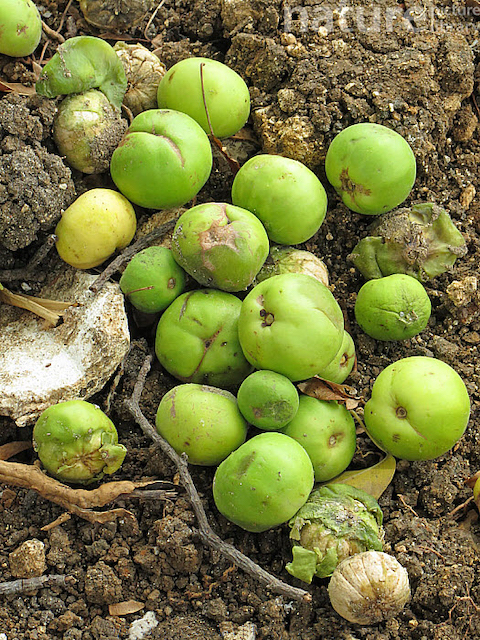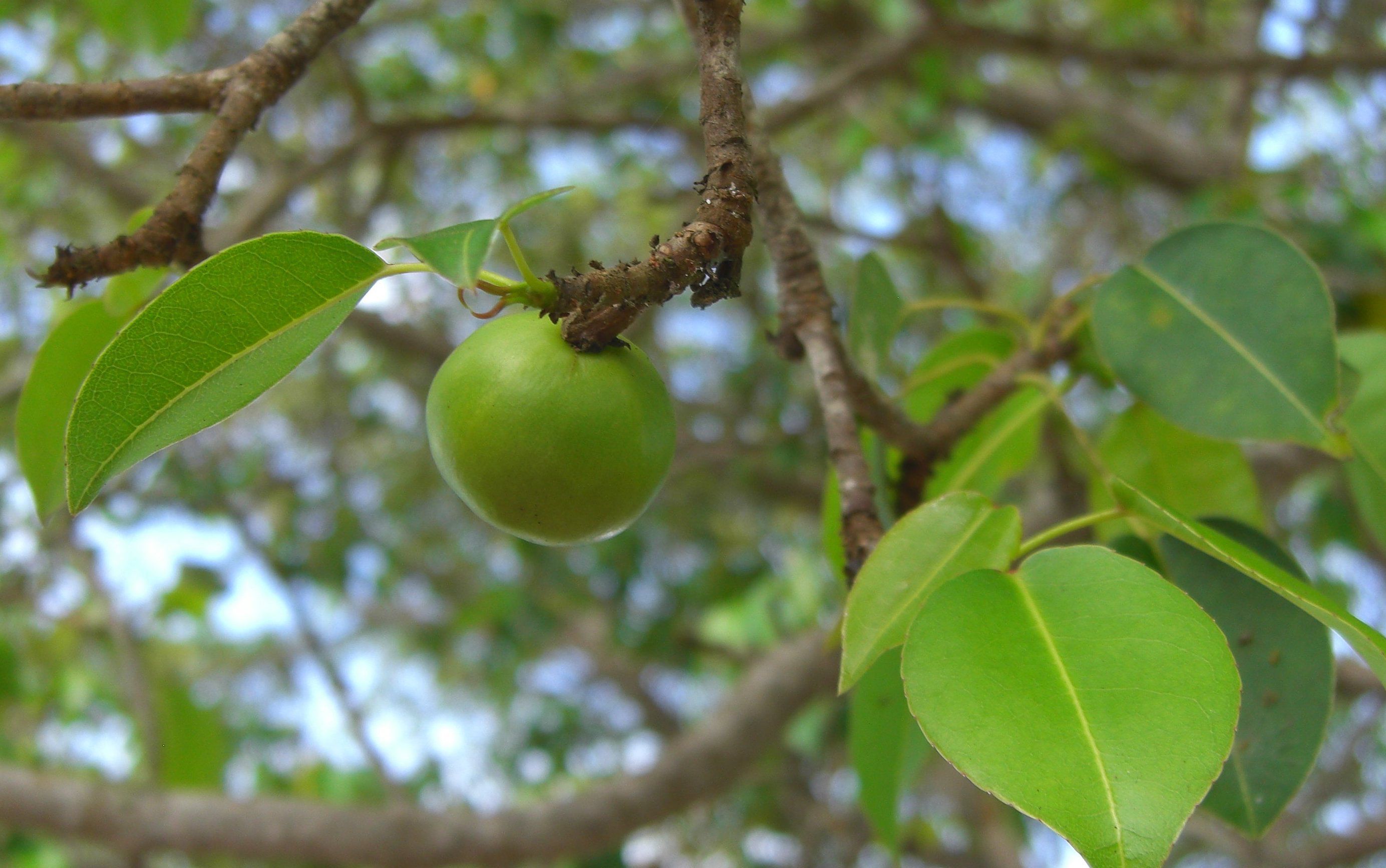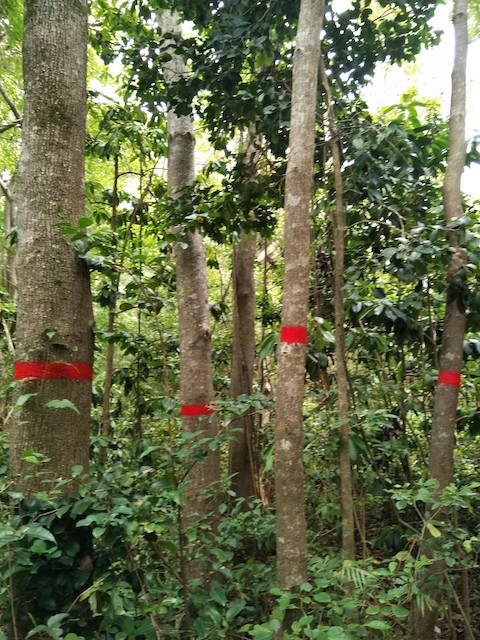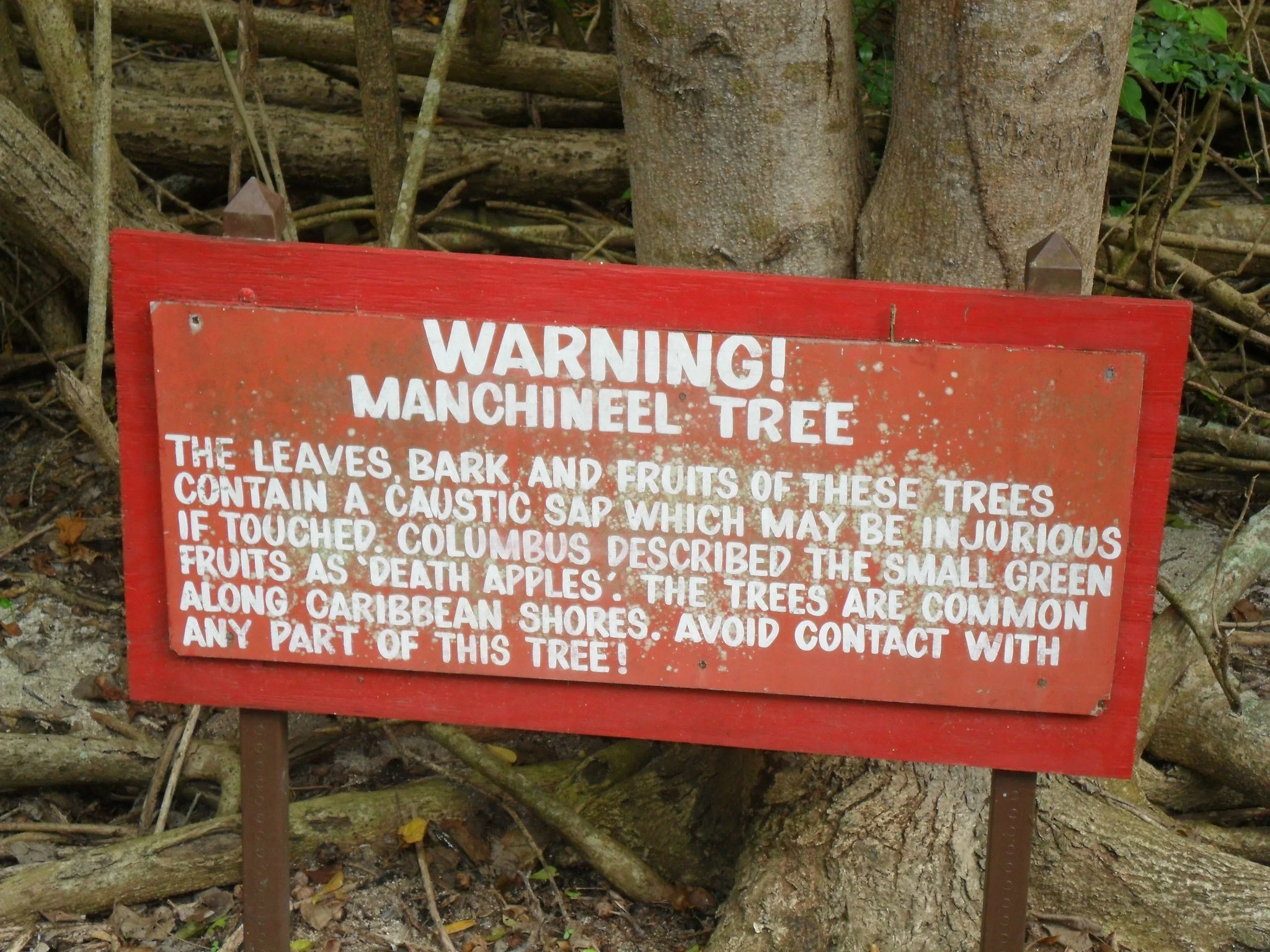
Credit: Adrian Davies
Imagine walking down a beautiful tropical beach. You spot a fruit on the sand, like a plum or small ripe apple. It smells sweet, so you wash it in the water and you’re about to take a bite…
But wait! You may have in your hand a Death Apple, the fruit of the manchineel, a tree that’s relatively common to the tropical beaches of the Americas.
Despite its good looks, the manchineel is listed in the Guinness Book of Records as the most dangerous tree in the world. Every part of it is highly toxic.
The juice of its fruit, had you eaten it, damages the entire digestive tract. It burns the throat and causes it to swell dangerously, and produces severe abdominal pain, vomiting, and bleeding that can lead to fatal dehydration.
Its sap is even worse. A single drop can burn the skin and blind the eyes. And it’s water soluble. Rainwater dripping off the tree can cause painful welts or burn the paint off a car. Breathing air laced with the sap after a rain or smoke when the wood is burned can asphyxiate.
And if the sap reaches the bloodstream, it can kill. Ponce de León, the famous explorer, is thought to have died from a native arrow dipped in the sap of the Manchineel.
Habitat loss and efforts to eradicate it are reducing the manchineel’s numbers. But, if you’re on a Caribbean or Central American beach and see trees with red markers on the trunks, be sure to give them a very wide berth.
The Death Apple is truly forbidden fruit.
Background
Synopsis: Nature can be treacherous in the tropics, and the manchineel tree is no exception. Listed as Earth’s most dangerous tree in the Guinness Book of World Records, its sap is said to have killed Spanish explorer Juan Ponce de León. Every part of the tree is toxic, and just standing under it in a rainstorm can give you burning contact dermatitis.

Credit: Jason Hollinger (CC BY)
- Manchineel is part of the spurge or Euphorbiaceae family, making it a cousin of ornamental holiday poinsettias. Here is how to identify it:
- The trees grow in clusters and live in brackish-water coastal environments.
- It is an attractive tree with a round crown that may grow to heights of 50 ft (15 m). The trunks are up to 2 ft (60 cm) in diameter with reddish-grey bark.
- It has shiny leathery leaves in an alternating pattern on long stems.
- Its yellow-green flowers are small and grow on spikes.
- It bears 1–2 inch (2–5 cm), sweet-smelling, green to yellow to orange fruits that each contain a stone with 6–9 seeds. The fruit resembles crabapples or plums, making it especially dangerous to children.
- The tree will typically be marked with red Xs or red rings painted around their trunks to warn unsuspecting visitors about their extreme toxicity. Additionally, signs warning of their danger are placed on or near the trees.

Credit: Skimel (CC BY-SA)
- In 1999, medical professional Nicola Strickland took a beach holiday to the Caribbean island of Tobago and had a memorable encounter with the fruit of the manchineel tree. She published her unfortunate experience in the British Medical Journal.
- She saw a small fruit on the beach that resembled a ripe crabapple or plum. It was sweet-smelling, so she took a tiny bite, then offered it to a friend. It was a manchineel beach apple.
- They felt a peppery taste in their mouths, then a tearing, burning sensation followed by a tightening of their throats until they could barely swallow.
- They developed the sensation of a big lump in their throats, and swallowing milk was the only way to soothe the pain.
- It took eight hours for the mouth and throat pain to decrease, but then the lymph nodes in their necks swelled up and became tender to the touch.
- They survived the frightening ordeal because they had ingested only a tiny amount of the fruit’s juice.
- Many members of the Euphorbiaceae family have poisonous sap and toxic fruits, but every part of Earth’s most dangerous tree is toxic to most animals.
- Some of the manchineel tree’s toxins are fast acting, while other are slow.
- The tree’s milky sap contains phorbol, which flows through the wood, bark, and leaves. Contact with the sap causes rashes, headaches, dermatitis, breathing problems, and temporary blindness. A single drop can burn the skin like an acid burn. Even brushing gently against its leaves or leaning against its trunk can cause a skin reaction like a scald.
- Phorbol is water soluble, so rain can pick up the sap as it drips down through the trees. The phorbol-laced rain then washes down onto anything below the tree’s canopy, burning everything from paint on cars to unfortunate people.
- Just standing too close to the tree and inhaling the toxin may cause dangerous inflammation of throat, which can lead to asphyxiation if the throat closes.
- If it reaches the bloodstream, the sap’s toxin may cause death.
- The sweet-tasting fruit’s toxins damage the digestive tract, causing symptoms including agonizing abdominal pain, vomiting, and bleeding that can lead to fatal dehydration.
- Burning the manchineel’s wood produces a toxic smoke that irritates the skin, lungs, and eyes, potentially blinding bystanders.

Credit: arctic_whirlwind/Flickr
- Historically, the harmless-looking trees are known to have poisoned conquistadores, shipwrecked sailors, and tourists.
- Juan Ponce de León led the first European expedition to Florida in 1513. Directed by Spain’s king, Ferdinand II, to settle the land, he returned to Florida in 1521. In a battle with the local Calusa tribe, he was wounded in the thigh by one of their arrows. He fled to Cuba and died of his wounds soon afterward. The natives in the area used manchineel sap the to poison the tips of their arrows—historians think this is what killed Ponce de León.
- There are stories of the trees being used to torture prisoners. They were tied to the trees in the rain, resulting in blistering and burning injuries.
- Ships’ records from the 1700s state that crews sent ashore to cut the attractive trees for firewood suffered two weeks of blindness after rubbing their eyes.
- Shipwrecked sailors have been known to eat the fruit and suffer blistering of their mouths and inflammation.
- The intense toxicity of the manchineel is a bit of a mystery to scientists, as consumption of its fruit and distribution of its seeds by herbivores would enable the plant to propagate efficiently. But mammals avoid the trees for good reason.
- The fruit drops into coastal waters to be distributed by tides and currents. When it rots, the seeds take root, similar to coconuts.
- One iguana from Central and South America, the garrobo striped lizard, seems invulnerable to the tree’s toxins and can slither among the branches enjoying the plum-like fruit without worrying about predators.
- The trees aren’t all bad.
- With their deep roots, they form natural windbreaks that prevent erosion during tropical storms and hurricanes.
- Native people have used products from the tree as medicines. After being dried the fruit can be used as a diuretic, and gum made from the bark is used to treat edema.
- Over the centuries, Caribbean carpenters have made beautiful furniture from manchineel wood. To harvest the wood, they avoid using axes and burn the tree at its base instead. They then dry it in the sun to neutralize the sap.
- While the manchineel tree is the deadliest tree on Earth, it is not the deadliest plant. That honor goes to the spotted water hemlock—just one-fourth inch (6 mm) will kill a human

